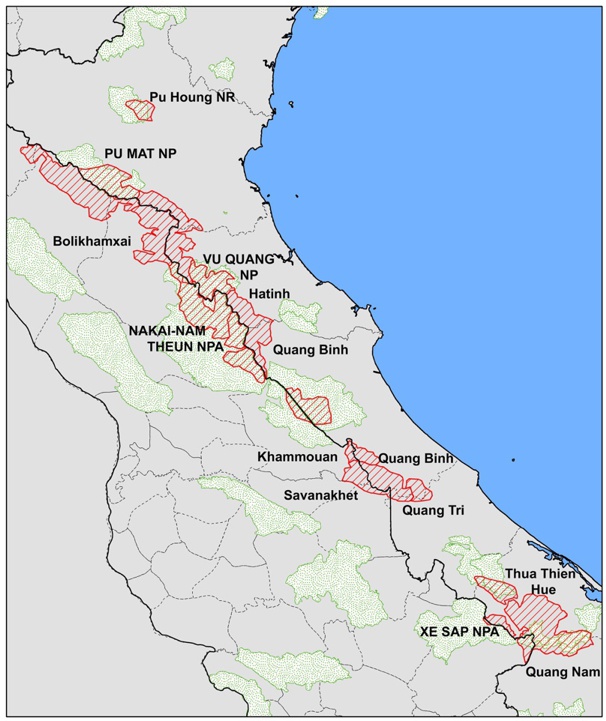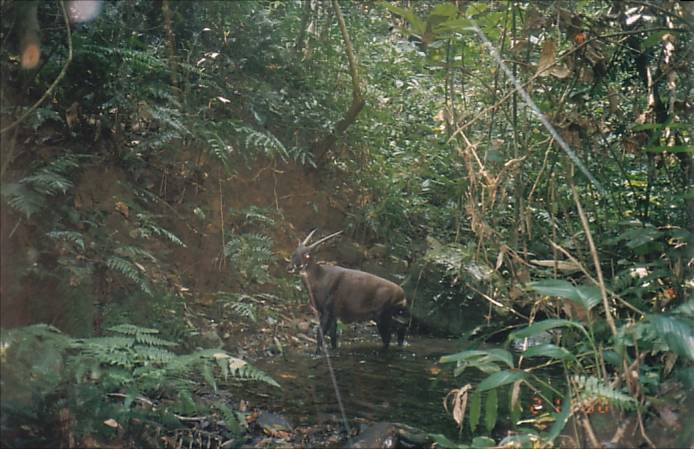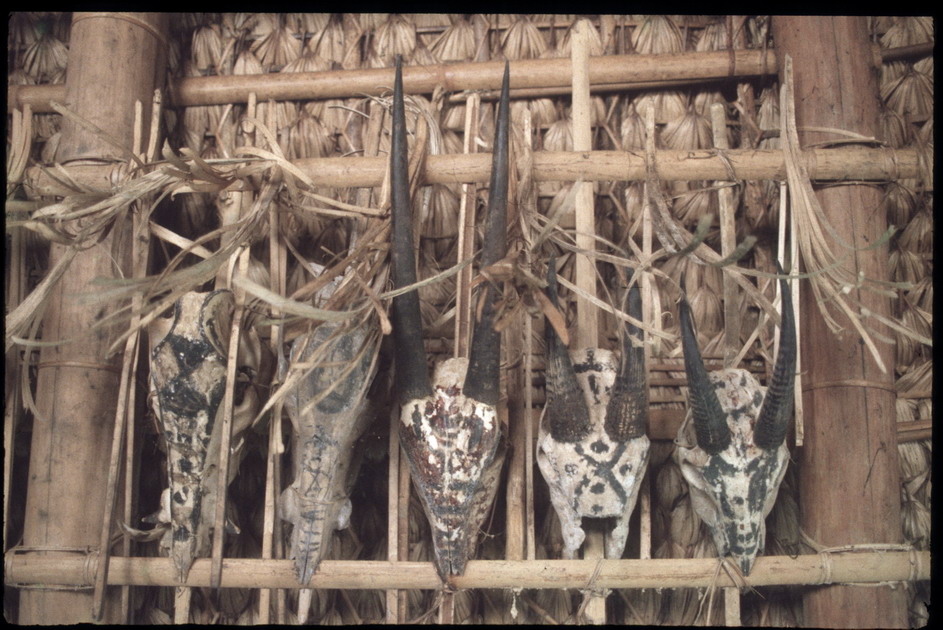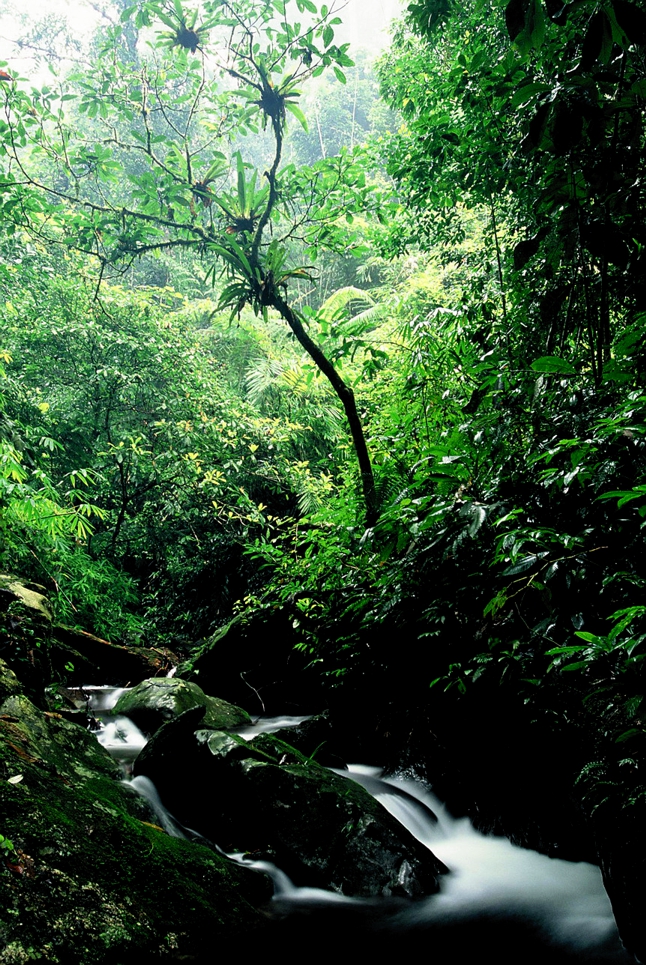I vividly remember reading about the discovery of the Saola (Pseudoryx nghetinhensis) in the BBC Wildlife Magazine whilst sitting in my traditional English school library. I was transfixed by the discovery of a distinctive, one-and-a-half-meter long, 70 kilogram ungulate with long tapered horns in the forests of Vietnam. I vowed there and then to work on and help the species however I could. Twenty-six years later I am still keeping that vow, but time is running out. It is going to take an incredible effort to stave off extinction and put the Saola on the path to recovery toward a fully functioning population.
The discovery of the Saola in 1992 has been heralded as one of the most spectacular zoological discoveries of the 20th century, not only because of the size and beauty of the species, but also because of its phylogenetic distinctiveness; the Saola sits alone in a monotypic genus. Its morphological and genetic characteristics suggest it is a primitive member of the tribe Bovini, along with the cattle and buffalo, within the family Bovidae.

The Saola is found in the North and Central Annamite Mountains of Vietnam and Laos where it is restricted to climatically wet evergreen, broadleaf forest habitats. These forests are subjected to an up to 10-month long rainy season, with no month receiving less than 40 mm of rain. This level of rainfall is the result of two monsoons, and determines the Saola’s distribution. The western and southern distribution of the Saola are bounded by the rain shadow of mountain chains with the western extent expanding deeper into Laos where the mountains dip, allowing deeper penetration of the northeast winter monsoon. These "everwet" forests survived throughout the Pleistocene and became centers of evolution, explaining why they are home to so many endemic species. This includes a suite of mammal species discovered after the Saola, including the Large-antlered Muntjac (Muntiacus vuquangensis), and Annamite Striped Rabbit (Nesolagus timminsi).

Local communities across the Saola’s range report that Saola are predominantly found within small, steep stream valleys. They also report that the animal’s favorite food plants are found in such valleys, and that when disturbed, Saola run to streams, back into a steep bank and lower their heads to defend themselves with their horns. This, and Saola’s instinctive fear reaction to dogs, is presumed to be a consequence of the Saola’s evolution amongst the sympatric Dhole (Cuon alpinus), which were likely the Saola’s main predator. Saola appear to be solitary except for females with calves and possibly loose, extended associations of males and females during the breeding season.
Most of what we know about the Saola comes from the knowledge of local communities as no one has conducted an ecological study of the species, no scientist has seen a Saola in the wild, and biologists have only studied a single captive animal in detail. Despite numerous—but insufficiently intense or sustained—camera-trapping efforts since 1998, only four successful camera-trap captures of Saola have been recorded in 1998, 1999, and 2013. This is probably due to a combination of factors including the animal’s rarity, a lack of understanding of the ecology of the species, which impacts camera-trap placement, and insufficient effort. For more than 15 years, efforts to conduct an intensive, long-term camera-trapping study to understand the distribution, density and micro-habitat selection of the species have been proposed by conservationists across the Saola’s range, but a lack of funding availability has prevented this from coming to fruition.

A Species on the Brink
Despite major gaps in our knowledge on the Saola, one thing is very clear: the Saola is extremely close to extinction and unless conservationists and other stakeholders take significant steps, it could be lost to the world within 30 years of its discovery. The IUCN Red List of Threatened Species lists it as Critically Endangered. The distribution of the Saola spans more than 450 kilometers of rugged mountainous terrain, but within this, its actual area of occupancy is both small and highly fragmented. If a site is defined as a unit of management, the Saola could be present in anywhere between zero and 25 sites, but it is likely this range is closer to between two and ten sites. Moreover, it is presumed by the most informed Saola conservationists that no site has a population greater than 20 individuals, and within a site the population may be comprised of multiple isolated individuals or tiny "sub-populations". Such conditions make it almost impossible for the species to maintain stable, let alone increasing, populations. Based solely on population demographics alone, conservationists believe that the species is in an irreversible extinction vortex in the wild. The lack of any animals in captivity compounds the extremely precarious status of Saola.
Historically the major threat to the Saola may have been habitat destruction. However, we don’t know much about the species’ presence in, or preference for, lowland forest, as most of this forest was lost prior to expensive biological exploration. The species, even today, has plenty of habitat to support functional populations so habitat loss cannot be blamed for the species’ current proximity extinction.
The multitude of indigenous peoples across the Annamites have hunted for subsistence for millennia. Some groups used spears, other bows and arrows. The impact of this historical hunting will never be understood, but it is likely it had little impact on the Saola, otherwise the species would have been driven to extinction decades—if not centuries—earlier, along with other long-lost large mammals.

The human population of Vietnam and Laos has grown rapidly since the 1950s aided by significant improvements to the countries’ healthcare systems since the late 1980s. Infrastructure development has boomed, pushing roads into even the most remote parts of the Annamites. All this has led to a significant increase in the human population living along the forest edge. In addition to an influx of lowlanders moving into the Annamite foothills, there has been a rapid transfer of technology to the indigenous peoples of the Annamites. Modern gun technology adopted during the years of war and civil unrest has been significantly reduced by decades of government effort, but some guns still remain in hunter’s hands. Snaring technology, primarily using bicycle break cable wire, spread across the Annamites in the 1990s and being cheap, readily available, and legal has become the technology of choice for hunters targeting terrestrial species.
Empty Forests
The introduction of wire snares into the Annamites has been devastating. The efficiency of wire snares means poachers can target anything and few animals trapped are able to escape. High-value species such as Tiger (Panthera tigris) and Rhinos (Rhinocerotidae sp.) were extirpated first, but the larger quarry species followed with species such as Sambar (Rusa unicolor), Gaur (Bos gaurus), and Bears (Ursinae sp.) being greatly reduced or extirpated across vast tracks of the Annamites. Smaller, more numerous, and faster-reproducing species such as Civets (Viverridae sp.), Porcupines (Hystricidae sp.), and Chevrotains (Tragulus sp.) are now rare across the region, with many species extirpated from vast areas. When communities of common species start to disappear from entire landscapes, the likelihood of survival for more naturally rare species such as the Saola plummets.
A larger human population, more road access to remote forest areas, and better technology does not, however, wholly explain the scale of poaching across the Annamites. The driving force behind this wholesale extermination of wildlife communities from the Annamites is the human demand for wildlife which is powering the commercial wildlife trade. Where species that are snared are concerned, this demand comes almost exclusively from the demand for wild meat, although some species also have traditional medicinal value. Wild meat is considered a delicacy and status symbol. With the incredible economic boom—neither Vietnam nor Laos has seen their GDP dip much below 5 percent per year since 1990—combined with the growing human population, this demand has grown to a degree that the forests of Vietnam and Laos cannot sustain and the Annamites have been stripped bare of much of their wildlife.
The result of this demand is industrial-level snaring across the Annamites where brush fences made of branches and leaves are on almost every ridge, some of them hundreds of meters or more long, each with a break every five meters in which a snare is placed. Any animal attempting to cross a ridge is caught, whether a 100 kg Wild Boar (Sus scrofa) or a 1 kg Ferret-badger (Melogale sp.). In some areas of the Annamites, the term “empty forest” is painfully accurate.

Efforts to protect the Saola have been ongoing since its discovery. Notably, at least four protected areas have been established directly to protect the Saola, and others have been established in part because of the presence of Saola. Even today, efforts continue to establish protected areas in the best habitat remaining. This is critical for biodiversity conservation efforts in the Annamites, and also to ensure that suitable sites remain for the recovery of the Saola in the future.
However, as noted, it is poaching that is driving the Saola, and many other species, to extinction. It is illegal to hunt in protected areas in both Vietnam and Laos, and it is illegal to hunt many species, including the Saola, even outside of formally protected areas. However, despite legal protection, poaching continues unabated. In the 1990s and early 2000s conservation projects were established to stop poaching through the Integrated Conservation and Development Project model. These largely failed to address poaching even when the livelihood goals were successfully met. There was a more concerted effort throughout the 2000s to address the lack of law enforcement, but a lack of willingness of the enforcement agencies to act resulted in little impact. After 2010, efforts shifted to empowering local communities to remove snares and report on poaching. This led to initial decreases in snaring in some priority areas, and while snaring was probably simply displaced, it does seem to have helped reduce the density of snares in some core Saola areas over time. Lack of available funding has severely hampered any efforts to intensify this approach and expand efforts to cover more priority areas.
The One Plan Approach
The Saola Working Group is part of the Asian Wild Cattle Specialist Group of the IUCN Species Survival Commission. Formed in 2006, the Saola Working Group is a collaborative effort to save the Saola from extinction. It is a network of about 35 specialists in field biology, law enforcement, community-based conservation, animal husbandry, and conservation breeding. Based on the combined knowledge of this group, the Saola Working Group believes that the Saola can now not be saved from extinction through field conservation efforts alone. The Saola Working Group have decided that it is now too dangerous to leave and Saola in the wild as we cannot adequately mitigate the threats to every individual of the species at this time.
Conservation breeding programs are a viable conservation solution that have brought many species back from the brink of extinction including the European Bison (Bison bonasus) and Scimitar-horned Oryx (Oryx dammah). There are currently no Saola in captivity, which means we must undertake wild captures. Because we believe no population of Saola is viable, removing animals from the wild will not harm the likelihood of survival in the wild at either the individual or population levels.
A handful of Saola have been kept in captivity over the past 25 years. None survived more than a few months, but the diet, husbandry, and veterinary care provided were not appropriate. The Saola Working Group has assembled some of the world’s most experienced experts in the capture, husbandry, and breeding of ungulates to ensure we provide the highest quality of care to any Saola caught and brought into captivity. Capturing any wild animal carries with it a level of risk, but leaving any Saola in the wild at this point is dooming it to death, and its species to extinction.
The Saola Working Group, IUCN Species Survival Commission, and the governments of Vietnam and Laos are currently working to finalize the details of a plan to capture and breed Saola. Under this plan a conservation breeding center is being established in Bach Ma National Park, Vietnam and will be managed with international best-practice expertise. A second conservation breeding center will be developed in Laos in the coming years if capture and breeding efforts are successful. If we can generate sufficient funding in time, we hope captures will begin in 2018.
Of critical importance to the conservation program is that a conservation breeding program is not the end goal for the Saola. Efforts by various conservation groups including the World Wide Fund for Nature, Wildlife Conservation Society, Global Wildlife Conservation, Fauna & Flora International, and VietNature continue to reduce snaring pressure in core Saola habitat. Parallel efforts are working on reducing the demand for wildlife meat, and the best sites for the reintroduction of Saola are being identified by the Saola Working Group . The aim is that when there are enough Saola in captivity to sustain offtake for reintroduction and when reintroduction sites are declared safe enough, Saola can be reintroduced back into the wild. This "one plan approach" provides the framework for a long-term and comprehensive recovery program for the Saola.

So can we save the Saola from extinction? Yes, technically we can save the Saola; an energized, skilled group of experts has developed a plan that would save the Saola and provide it with an opportunity to recovery. This remains an extremely challenging task, not least in identifying where, and how, to safely capture a Saola. If anyone can save the Saola, it is the collective knowledge and drive of those in the Saola Working Group. Can sites be adequately protected from snaring to enable eventual reintroduction of the Saola into the Annamites? This will take time, but with increased law enforcement and an inter-generational change in behavior it can—and will—be possible. The biggest question is whether the world will rally behind the effort and offer sufficient help. Unfortunately, even the best plans are only plans until they get off the page and turn into action. Action requires money, and it is the availability of sufficient funding—or the lack of it—that is likely to determine whether we can save the Saola from extinction.
Further reading on this topic:
- https://www.savethesaola.org/
- Tilker A, Long B, Gray T, Robichaud W, Van Ngoc T, Vu Linh N, Holland J, Shurter S, Comizzo P, Thomas P, Ratajszczak R, and Burton J (2017) Saving the saola from extinction. Science 357: 1248
- Robichaud W and Long B (2014) Saola Pseudoryx nghetinhensis. In: Ecology, Evolution and Behaviour of Wild Cattle, Implications for Conservation (Eds: Melletti M and Burton J) Cambridge University Press
- Timmins RJ, Hedges S, and Robichaud W (2016) Pseudoryx nghetinhensis The IUCN Red List of Threatened Species 2016: e.T18597A46364962
- Gray TNE, Hughes AC, Laurance WF, Long B, Lynam AJ, O’Kelly H, Ripple WJ, Seng T, Scotson L, and Wilkinson NM (2018) The wildlife snaring crisis: an insidious and pervasive threat to biodiversity in Southeast Asia. Biodiversity Conservation 27: 1031–1037
- Gray TNE, Lynam AJ, Teak S, Laurance WF, Long B, Scotson L, and Ripple WJ (2017) Wildlife-snaring crisis in Asian forests. Science 355: 255-256
- Wilkinson NM and Van Duc L (2017) Rank aggregation of local expert knowledge for conservation planning of the critically endangered Saola. Conservation Biology, 31: 625-634
 Zoology
Zoology
Responses